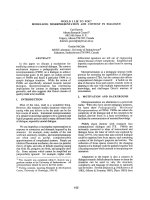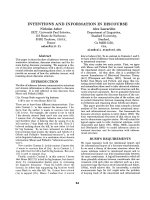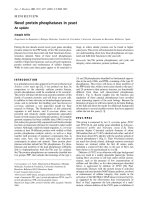Báo cáo sinh học: " Autosomal recessive myotonia in sheep" doc
Bạn đang xem bản rút gọn của tài liệu. Xem và tải ngay bản đầy đủ của tài liệu tại đây (232.48 KB, 4 trang )
Original
article
Autosomal
recessive
myotonia
congenita
in
sheep
GA
Moore
KR Dyer
2
RM
Dyer
DP
Sponenberg
4
1
Department
of
Large
Animal
Clinical
Sciences;
2
Department
of
Small
Animal
Clinical
Sciences;
4
3
Department
of
Clinical
Sciences,
Maryland;
’-
4
Department
of
BioSciences
and
Pathobiology,
Virginia-Maryland
Regional
College
of
Veterinary
Medicine,
Virginia
Polytechnic
Institute
and
State
University,
Blacksburg,
VA
24061,
USA
(Received
6
August
1996;
accepted
10
March
1997)
Summary -
Myotonia
congenita
in
sheep
causes
episodes
of
muscular
rigor
following
various
stimuli.
Episodes
are
transitory
and
do
not
harm
the
animal.
Incidence
in
the
flock
of
origin
included
three
ewe
lambs
and
three
ram
lambs.
Two
of
the
affected
animals
resulted
from
the
mating
of
one
specific
unaffected
ram
to
the
unaffected
daughters
of
a
second
unaffected
ram.
This
mating
produced
25
normal
animals
in
addition
to
the
two
myotonic
animals,
which
is
consistent
with
the
hypothesis
of
an
autosomal
recessive
gene
responsible
for
the
condition,
assuming
the
sire
and
maternal
grandsire
were
the
only
ancestors
carrying
the
gene
(x
2
=
0.64,
1
df,
P
>
0.25).
The
four
other
affected
animals
had
these
two
introduced
rams
in
their
pedigrees
on
both
maternal
and
paternal
sides,
suggesting
that
these
two
rams
might
indeed
have
introduced
the
gene
into
this
flock.
sheep
/
myotonia
congenita
/
genetics
R,ésumé -
Myotonie
congénitale
autosomale
récessive
chez
le
mouton.
La
myotonie
congénitale
chez
le
mouton
cause
des
épisodes
de
raideur
musculaire
suite
à
divers
stimuli.
Ces
épisodes
sont
passagers
et
ne
sont
pas
nuisibles
à
l’animal.
Elle
concernait
trois
agneaux
mâles
et
trois
agneaux
femelles
dans
le
troupeau
d’origine.
Deux
des
animaux
a,!‘’éctës
résultaient
de
l’accouplement
d’un
bélier
non
affecté
avec
les
filles
non
affectées
d’un
second
bélier
non
affecté.
Cet
accouplement
a
produit
25
animaux
normaux
en
plus
des
animaux
myotoniques,
ce
qui
est
cohérent
avec
l’hypothèse
d’un
gène
autosomal
récessif
responsable
du
syndrome,
en
supposant
que
le
père
et
le
grand-père
maternel
étaient
les
seuls
ancêtres
portant
le
gène
(x
2
=
0,64,
1
df,
p
>
0,25).
Les
quatre
autres
animaux
*
Correspondence
and
reprints.
Correspondence
to
be
sent
to
Dr
DP
Sponenberg,
Veterinary
College,
Virginia
Tech
Blacksburg,
VA
24061.
affectés
avaient
ces
deux
béliers
dans
leurs
pedigrees,
tant
du
côté
paternel
que
du
côté
ntaterael,
ce
qui
suggère
que
ces
deux
béliers
pourraient
avoir
introduit
le
gène
dans
le
troupeau.
ovin
/
myotonie
congénitale
/
génétique
INTRODUCTION
Myotonia
congenita
is
a
condition
of
skeletal
muscles,
which
is
characterized
by
rigid
contraction
of
the
muscles,
generally
following
a
startling
stimulus.
Myotonia
congenita
has
been
described
in
humans,
goats
and
other
species
(Bryant,
1979;
Ptacek
et
al,
1993).
Myotonia
congenita
is
distinct
from
hyperkalemic
periodic
paralysis,
paramyotonia,
as
well
as
from
myotonic
dystrophy.
Myotonia
congenita
in
humans
has
two
major
forms.
One
is
due
to
an
autosomal
dominant
gene
and
the
other
is
due
to
an
autosomal
recessive
gene
(Ptacek
et
al,
1993).
Myotonic
animals
are
consistently
heavily
muscled,
and
this
development
of
muscle
is
related
to
the
myotonia.
The
heavy
muscling
of
myotonic
animals
may
offer
some
advantages
to
meat
production
systems.
Myotonic
sheep
occurred
in
a
single
flock,
and
flock
records
were
studied
to
determine
the
mode
of
inheritance
within
this
flock.
MATERIALS
AND
METHODS
Myotonia
congenita
in
sheep
was
detected
in
a
flock
that
was
used
for
the
production
of
show
lambs.
Two
affected
sheep
from
the
flock
were
evaluated
by
routine
blood
and
urine
analyses.
These
two
sheep
were
also
evaluated
by
electromyography.
Samples
from
the
biceps
femoris
muscle
were
evaluated
histologically
following
routine
processing
for
hematoxylin-
and
eosin-stained
tissue
sections.
Flock
records
of
pedigrees,
production
data,
and
evaluation
of
lambs
as
affected
and
unaffected,
were
evaluated
for
evidence
of
mode
of
genetic
transmission
of
the
myotonia
congenita.
RESULTS
Clinical
investigation
of
two
affected
animals
from
the
flock
revealed
normal
com-
plete
blood
counts,
normal
biochemical
profiles,
and
normal
levels
of creatine
kinase.
Urine
analysis
was
also
normal.
The
only
histological
change
was
hypertrophy
of
both
type
I
and
type
II
myofibers
in
the
biceps
femoris
muscles.
Several
muscles
of
each
lamb
were
investigated
electromyographically,
and
all
of
these
exhibited
classic
myotonic
potentials
(Kimura,
1983).
The
myotonic
dis-
charges
occurred
as
sustained
runs
of
positive
or
negative
waves
up
to
1
mV.
These
ranged
about
50-100
impulses
per
second,
which
produced
a
diminishing
buzz
over
the
speaker
of
the
electromyograph.
This
diminishing
buzz
is
characteristic
of
my-
otonia
congenita.
Evaluation
of
herd
records
revealed
that
myotonia
congenita
was
only
expressed
in
lambs
descended
from
two
specific
rams
that
were
themselves
unaffected,
and
not
from
two
other
unaffected
rams
that
were
also
used
in
the
flock.
The
two
rams
capable
of
producing
affected
lambs
produced
six
affected
lambs,
three
ram
lambs
and
three
ewe
lambs.
Two
of
the
affected
lambs
resulted
from
the
mating
of
one
specific
ram
to
the
unaffected
daughters
of
the
other
ram,
this
specific
combination
also
producing
25
unaffected
lambs.
The
other
four
affected
lambs
were
the
progeny
of
animals
that
were
offspring
or
paternal
grandoffspring
of
one
of
the
rams,
and
maternal
grandoffspring
of
the
other.
No
affected
lambs
were
produced
from
any
mating
that
did
not
have
at
least
one
of
these
rams
in
both
the
maternal
and
paternal
portion
of
the
pedigree.
These
two
rams
were
both
brought
into
the
flock
from
other
sources,
neither
was
born
into
the
flock.
DISCUSSION
The
clinical
investigation
was
consistent
with
this
disease
being
myotonia
congenita.
The
electromyography
was
consistent
with
this,
and
the
hypertrophy
of
the
skeletal
muscles
was
consistent
with
myotonia
congenita
and
not
with
dystrophic
diseases
characterized
by
myotonia.
If
an
allele
is
recessive
and
is
newly
introduced
into
a
population
by
an
heterozygous
male,
then
the
mating
of
this
heterozygous
male
to
daughters
of
an
heterozygous
male
(himself
or
another)
should
produce
a
1:7
ratio,
which
fits
the
production
of
25
unaffected
and
two
affected
lambs
by
one
ram
from
daughters
of
another
(x
2
=
0.64,
1
df,
p
>
0.25).
This
logic
is
correct
only
if
the
original
flock
lacked
animals
heterozygous
for
this
gene,
in
which
case
the
original
frequency
of
the
gene
is
zero.
The
pedigree
information
behing
the
four
myotonic
lambs
that
were
not
produced
by
the
specific
sire
x
maternal
grandsire
matings
are
consistent
with
the
gene
being
introduced
by
the
two
rams
and
not
existing
in
the
flock
before
their
use.
The
only
instances
of
affected
lambs
in
this
flock
followed
matings
in
which
these
two
rams
appeared
in
both
the
maternal
and
paternal
pedigrees.
In
no
other
instance
were
affected
lambs
produced,
which
is
evidence
against
this
gene
existing
in
the
flock
before
these
two
rams
were
introduced.
The
overall
production
of
three
ram
and
three
ewe
lambs
affected
with
myotonia
congenita
further
indicates
a
lack
of
sex
linkage
for
the
gene
responsible
for
this
trait
in
sheep.
The
name
Myotonia
congenita
is
suggested
for
the
locus
of
this
allele,
with
the
symbol
Mc.
The
allele
name
myotonic
is
suggested
for
the
recessive
allele,
with
the
symbol
Mc7&dquo;!.
This
allele
was
unfortunately
not
documented
prior
to
the
publication
of
Mendelian
Inheritance
in
Sheep
(MIS
196)
(Lauvergne
et
al,
1996),
and
the
authors
suggest
that
it
be
included
in
the
next
catalogue
with
the
proposed
names
and
symbols.
Myotonia
congenita
in
sheep
is
similar
to
that
in
goats
(Bryant,
1979)
and
humans
(Ptaced
et
al,
1993).
Clinical
signs
in
the
lambs
were
first
noted
at
a
few
weeks
to
a
few
months
of
age.
The
first
clinical
sign
was
that
the
affected
lambs
had
dirty
fleeces.
This
is
unusual
in
normal
sheep
since
they
rarely
if
ever
recline
laterally
or
roll,
which
generally
keeps
fleeces
clean
and
free
of
soil.
The
affected
lambs
were
then
observed
to
exhibit
extensor
rigidity
in
the
face
of
various
stimuli,
as
is
common
with
myotonia
congenita
in
other
species.
This
rigidity
can
occasionally
cause
them
to
fall
over,
and
this
accounts
for
the
dirty
fleeces
as
the
lambs
begin
to
express
the
trait.
The
affected
lambs
were
subjectively
considered
by
the
flock
owner
to
have
heavier
muscling
than
the
unaffected
lambs.
Further
study
of
this
aspect
of
myotonia
congenita
was
not
studied
since
only
affected
lambs
were
donated
for
evaluation.
If
further
studies
indicate
that
myotonic
lambs
are
more
heavily
muscled
than
non-
myotonic
lambs,
then
this
allele
might
have
applications
in
meat
producing
systems.
Another
recently
documented
gene
with
large
effect
on
muscling
is
the
callipyge
gene
(Jackson
and
Green,
1993),
which
unfortunately
also
results
in
toughness
of
some
portions
of
the
carcass.
The
non-expression
of
the
callipyge
allele
in
animals
inheriting
it
from
the
dam
also
may
limit
its
usefulness
in
production
systems
(Cockett
et
al,
1996).
REFERENCES
Bryant
SH
(1979)
Myotonia
in
the
goat. Anns
N Y
Acad
Sci
317,
314-325
Cockett
NE,
Jackson
SP,
Shay
TL,
Farnir
F,
Berghmans
S,
Snowder
GD,
Nielsen
DM,
Georges
M
(1996)
Polar
overdominance
at
the
ovine
callipyge
locus.
Science
273,
236-
238
Jackson
SP,
Green
RD
(1993)
Muscle
trait
inheritance,
growth
performance,
and
feed
efficiency
of
sheep
exhibiting
a
muscle
hypertrophy
phenotype.
Proc
West
Sect
Amer
Soc
Anim
Sci
44,
364-366
Kimura
J
(1983)
Electrodiagnosis
in
Diseases
of
Nerve
and
Muscle.
Principles
and
Practice.
EA
Davis
Co,
Philadelphia,
259-288
Lauvergne
JJ,
Dolling
CHS,
Renieri
C
(1996)
Mendelian
Inheritance
in
Sheep
1996
(MIS
96).
COGOVICA/COGNOSAG
and
University
of
Camerino,
Clamart,
France
and
Camerino,
Italy
Ptacek
LJ,
Johnson
KJ,
Griggs
RC
(1993)
Genetics
and
physiology
of
the
myotonic
muscle
disorders.
N
Engl
J
Med
328, 482-488









